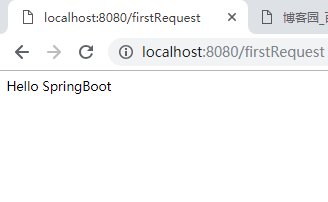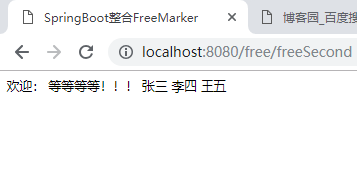SpringBoot
案例一
1、导入依赖
</properties>
<parent>
<groupId>org.springframework.boot</groupId>
<artifactId>spring-boot-starter-parent</artifactId>
<version>1.4.1.RELEASE</version>
</parent>
<dependencies>
<dependency>
<groupId>junit</groupId>
<artifactId>junit</artifactId>
<version>4.11</version>
<scope>test</scope>
</dependency>
<dependency>
<!-- spring-boot-starter-web是为我们提供了包括mvc,aop等需要的一些jar -->
<groupId>org.springframework.boot</groupId>
<artifactId>spring-boot-starter-web</artifactId>
<!-- 因为我们已经配置了 parent 中的version 所以这里不需要指定version了 -->
</dependency>
2、创建FirstController类
@RestController
public class FirstController {
@RequestMapping("/firstController")
public String firstController(){
System.out.println("第一个请求");
return "Hello SpringBoot";
}
}
3创建StartSpringBoot 测试类
@SpringBootApplication
public class StartSpringBoot {
public static void main(String[] args) {
SpringApplication.run(StartSpringBoot.class,args);
}
}
网页访问


二、SpringBoot静态资源访问
1、在resources文件下创建static包,再static下创建img包



三、SpringBoot解决异常问题
1、在Controller类中定义一个异常
@RestController
public class FirstController {
@RequestMapping("/firstController")
public String firstController(){
int result=5/0;
System.out.println("第一个请求");
return "Hello SpringBoot";
}
}
2. 定义异常类
@ControllerAdvice
public class ExceptionHan {
@org.springframework.web.bind.annotation.ExceptionHandler(RuntimeException.class)
@ResponseBody
public Map<String,Object> exceHandler(){
Map<String,Object> map=new HashMap<>();
map.put("error","500");
map.put("msg","异常");
return map;
}
3、结果如下

四、SpringBoot使用freemarker
1、导入依赖freemarker
<dependency>
<groupId>org.springframework.boot</groupId>
<artifactId>spring-boot-starter-freemarker</artifactId>
</dependency>
2、配置application.propertiesleuk文件
## Freemarker 配置 spring.freemarker.template-loader-path=classpath:/templates/ spring.freemarker.cache=false spring.freemarker.charset=UTF-8 spring.freemarker.check-template-location=true spring.freemarker.content-type=text/html spring.freemarker.expose-request-attributes=false spring.freemarker.expose-session-attributes=false spring.freemarker.request-context-attribute=request spring.freemarker.prefix=/ spring.freemarker.suffix=.ftl
3、在resources包下创建templates包并创建holle.ftl模板
<!DOCTYPE html>
<html lang="en">
<head>
<meta charset="UTF-8">
<title>SpringBoot整合FreeMarker</title>
</head>
<body>
欢迎:
` ${name}
<#list stulist as stu>
${stu.stu_name}
</#list>
<#if 1==1>
等等等等!!!
</#if>
<#list userList as user>
${user}
</#list>
</body>
</html>
4、创建StartSpringBoot启动类
package com.freemarker;
import org.springframework.boot.SpringApplication;
import org.springframework.boot.autoconfigure.SpringBootApplication;
@SpringBootApplication
public class StartSpringBoot {
public static void main(String[] args){
SpringApplication.run(StartSpringBoot.class,args);
}
}
5、创建Controller类freemarkerController类
package com.freemarker.Controller;
import com.freemarker.entity.student;
import org.springframework.stereotype.Controller;
import org.springframework.ui.ModelMap;
import org.springframework.web.bind.annotation.RequestMapping;
import java.util.ArrayList;
import java.util.List;
@Controller
@RequestMapping("/free")
public class freemarkerController {
@RequestMapping("/freeFirst")
public String freeFirst(ModelMap map){
map.put("name","张三");
return "hello"; //找templates/name.ftl
}
@RequestMapping("/freeSecond")
public String freeSecond(ModelMap map){
List<String> list=new ArrayList<>();
list.add("张三");
list.add("李四");
list.add("王五");
map.put("userList",list);
return "hello";
}
@RequestMapping("/freeThread")
public String freeThread(ModelMap map){
List<student> list=new ArrayList<>();
student stu=new student();
stu.setStu_id(1);
stu.setStu_name("小王");
list.add(stu);
map.put("stulist",list);
return "hello";
}
}
6、页面访问实现效果如下




